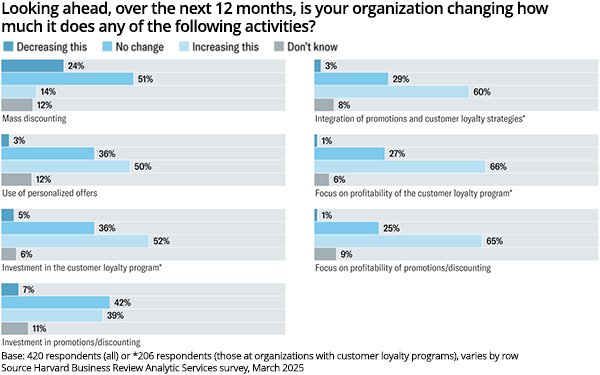
Google began giving merchants a way to lure first-time shoppers to
make purchases with them. The company launched 1st Order Promotions, known as New Customer Promotions for Shopping ads. It lets
brands offer exclusive discounts to new buyers in paid listings.
It's an example of the changing landscape
of promotions and discounts, as artificial intelligence (AI) helps marketers move away from mass discounts and toward personal targeting easier, but companies say there are so many hurdles
accomplishing it that time and money spent may not be worth it. Data is key.
Among respondents at organizations surveyed by Harvard Business Review and sponsored by
Talon.One, once they started personalizing promotions and discounts, about 62% say they have seen increased sales as a result. HBR Analytic Services in March discovered this after
surveying 420 members of its audience online.
advertisement
advertisement
Forty-seven percent said it is increased customer loyalty, and 44% say it has delivered a better customer experience. Personalization is not
always easy to achieve. Some companies are stifled by inadequate data and technology.
Customer data issues and technology or software issues are the most common barriers to personalization,
say respondents at organizations that do not currently offer personalized promotions and discounts.
Half the time, incentives for discounts when making purchases online do not work, and there
are many hurdles.
Thirty-two percent said low-quality and siloed data is a challenge, 32% said technology and software issues create concerns, 28% note other business initiatives take
priority, and 25% note unclear business values or return on investments.
HBR’s study -- compiled from the survey Getting Strategic About Incentives -- found that companies need to stop
treating incentives as a cost center and begin using them as a driver for value.
It means using data to understand what motivates customer behavior and integrating loyalty into the full
customer journey, not just at checkout. Offers need to adapt in real-time, guided by business objectives rather than falling back on blanket discounts.
Value-conscious consumers are more
selective in how and where they spend money, and there is no reason marketers cannot become more responsive with artificial intelligence now by their side. It’s an enterprise strategy tied to
owning the customer relationship and the data that powers it.
Incentives are proving difficult to avoid. Some 77% of survey respondents at organizations with a customer loyalty program say
their efforts are either extremely or very important to their executive leadership team, while 71% say the same of promotions and discounts.
About 60% of respondents with a customer loyalty
program say their organization plans to increase the integration of promotions and customer loyalty efforts during the next 12 months.
And, 50% of respondents with a customer loyalty program
say their efforts with it are extremely or very effective, and 48% say this for activity around promotions and discounts.
In 2024, 40% of online shoppers in the United States wanted discounts
of between 10% and 20% off their ecommerce shopping carts, while one-third wanted as much as 20% to 30% off.
In the current economic climate, many businesses are finding they simply have to
give away some value in exchange to make a sale, according to Brett Hollenbeck, associate professor of marketing at the University of California, Los Angeles (UCLA) Anderson School of Management. The
comment appearing in the HBR study.
When asked during the study how effective is your organization at offering promotions and customer loyalty programs, only 15% said extremely effective for
promotion and discount programs, whereas only 17% said they are extremely effective for customer loyalty programs.
Here’s one of the biggest promotional mistakes that companies
make—when they are driven by the merchandising team as a means to shift excess stock, while customer loyalty programs—often in marketing functions—are seen by executives as
intrinsically more valuable and strategic, as they help attract and retain customers by rewarding them for repeat purchases.
Oliver Page, a principal with consulting firm Deloitte Consulting
LLP, told HBR for the study that, “price and quality are always going to be the top things for customers, but number three on their list is loyalty. Businesses can use loyalty as a very powerful
third lever in addition to product and price.”
The report shows how SiteOne Landscape Supply, a large distributor of equipment and supplies to landscape contracting businesses in the
United States, built loyalty into their core.
While SiteOne integrate discounts and promotions with its loyalty program to reward customers for their business, it goes beyond standard points
or discounts to drive loyalty. It provide Partners Program members—tools and technology that help grow their businesses like discounted rates for cell phone contracts or pre-negotiated less
expensive access for marketing or payroll platforms.
Update: This article was updated with information on Google's